► New Range Rover Sport comparison test
► Brit takes on BMW iX, Porsche Cayenne
► Three of the sportiest SUVs on sale in 2023
High-performance SUV buyers have never had it so good. Every European premium brand now offers a super-powered luxury crossover and CAR magazine recently tested the new Range Rover Sport against a typical petrol rival – Porsche’s Cayenne GTS Coupe – and the new alternative on the table, the all-electric BMW iX M60.
Read on for our full comparison test to see which we rate best.
Want to access more amazing content from CAR? Become a member of CAR here with a 99p trial!
Pre-flight briefing: Range Rover Sport P530
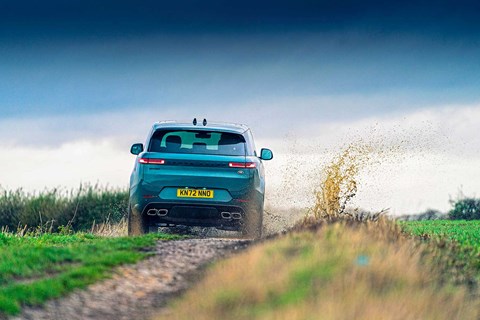
Why is it here?
The all-new Range Rover’s been praised to high heaven, and rightly so – it’s superb, and better than the Bentley Bentayga and Porsche Cayenne S E-Hybrid according to CAR’s Giant Test a few months back. As per the proven formula, the Sport takes those promising fundamentals and cranks up the driving-dynamics dial.
Any clever stuff?
New monocoque is big on EV-readiness (available as a plug-in hybrid for now, this Sport will go BEV before too long), rigidity and rear-wheel steering, which brings huge dynamic advantages (and means car parks needn’t bring on a panic attack). A switch from hydraulic to electric anti-roll control saves CO2 and boosts response times. Range-topping P530 First Edition layers on the go-faster tech, not least with an electronic active differential and torque vectoring by brake
Which version is this?
The Sport at its most sporty (and expensive), and the king of the hill dynamically – twin- turbo V8 power and hang the hybridisation. The other powertrain options are myriad: D300 and D350 mild hybrids, plug-in hybrids with two power outputs – badged P440e (from £85k) and P510e (from £109k) – and the £87k P400 mild-hybrid petrol straight-six.
Pre-flight briefing: BMW iX M60
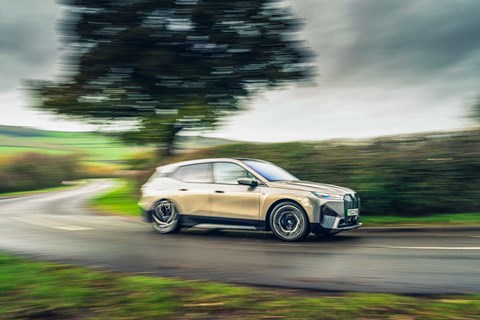
Why is it here?
Because the ultra-rapid SUV went electric a long time ago, with Tesla’s Model X, and now, as it proliferates, it’s proving a compelling combination. After all, if a car’s already big, heavy and expensive, adding big, heavy and expensive batteries is relatively straightforward. The iX has been with us a while but this M60 version is brand new. Like the i4 M50, it’s not a true M car – that’ll arrive mid-decade – but it gets massaged hardware and pricing. At £117,000 and 610bhp, both the M5 Competition and the X7 M60 are conventionally-engined in-house rivals.
Any clever stuff?
A more rigid structure for a given weight is always a good thing, hence BMW’s preoccupation with carbonfibre. It turns up on M cars and it graced both the i3 and the i8. On the last-gen 7-series it braced the monocoque in key places and the iX uses the same approach, bolstering the aluminium structure with carbonfibre-reinforced plastic.
Which version is this?
The flagship. The xDrive40, which starts at £70k in Sport trim, gets a 71kWh (net)battery for a 252-264-mile WLTP range. This M60 offers a 105.2kWh battery for 338-349 miles.
Pre-flight briefing: Porsche Cayenne GTS Coupe
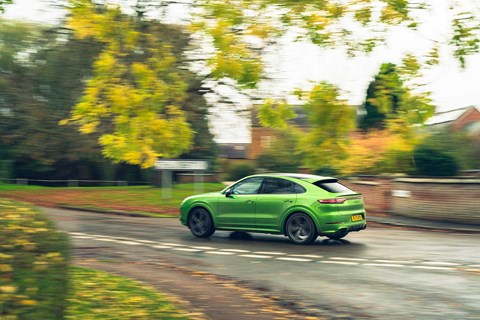
Why is it here?
Because last time out, with its astonishing refinement and crushing all-round ability, the Range Rover saw off the Cayenne, then in Turbo S E-Hybrid guise. The Porsche deserves another shot so it’s back, in uncomplicated GTS spec (V8 power, sporty tune, no fuss) to take on the Range Rover Sport. Back then we proclaimed the Cayenne the winner ‘if you’d be driving a 911 were it not for your infant and canine hangers-on’, though not in hugely quick, expensive but oddball Turbo S E-Hybrid Spec. The GTS is less expensive and less powerful but more cohesive as a performance SUV package, and should give us a fabulous dynamic yardstick.
Any clever stuff?
The Cayenne GTS is a magnificent device, and lovingly crafted ‘f*** you’ to physics. Standard equipment is steel springs, no rear-steer and steel brakes. Adaptive and self-levelling air suspension with adjustable ride height (£1511) is an option (fitted here ), as is rear-wheel steering (£1448, also fitted) and ceramic brakes (sensibly not fitted).
Which version is this?
The most focused, the Cayenne Coupe GTS, which sits near the middle of a vast range that kicks off with the £64k V6 Cayenne.
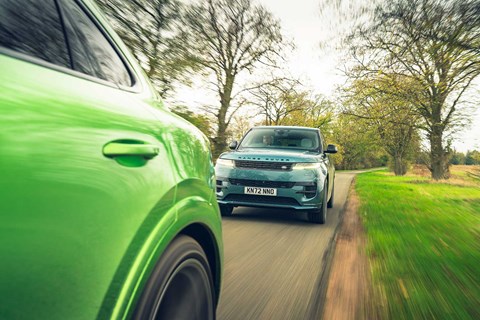
‘Well, that was exciting. At one point your Range Sport was moving in every direction except forwards.’
CAR’s James Taylor is both a very laid-back individual and a talented driver. As such, very little ruffles his feathers. And after watching my progress from the serene bridge of the bizarrely oxymoronic BMW iX M60 – a car that’s at once brutally rapid and ridiculously relaxing – his heart rate is exactly as it should: deep and crisp and even. After the Range Rover Sport’s slimy-road boogying, mine’s a little more ragged.
There is, we’re told, no such thing as bad weather, just the wrong clothes. Or the wrong car. And a new Range Rover Sport is surely the right car. Unfazed by the world and the weather beyond their glass, fast SUVs are perhaps the definitive all-weather performance cars. A good one lets you romp across even flooded, ice-ravaged landscapes in remarkable luxury, flippantly putting enormous power to the road in a manner unthinkable in a lesser vehicle.
The rain’s horizontal as I clamber into our Range Rover Sport and wake the BMW-derived 4.4-litre V8. There are one or two design chiefs integral to their brand but few for whom you can make the argument their work has been transformative. In sophisticated Giola Green with Light Cloud and Ebony leather, the new Sport is the embodiment of Gerry McGovern’s luxurification (sic) of Land Rover. It is magnificent in its unfussy, hewn-from-solid elegance, and its aesthetic merit is precisely why McGovern’s been packed off back down into his ideas quarry, hammer and pick in hand, and told not to emerge until he’s struck gold again, this time for sister brand Jaguar.
The best SUVs
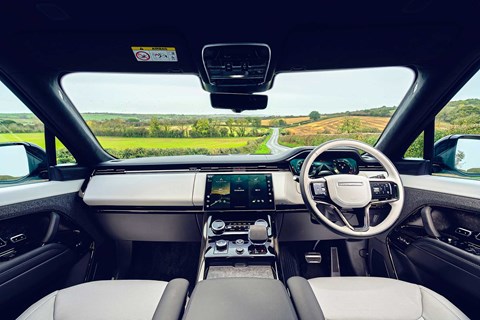
The Sport’s interior is entirely conventional in its layout but beautifully done (only the chrome plastic bezels to the climate controls feel cheap), particularly the beautiful and responsive main touchscreen (though it does go on strike for half an hour, refusing to show anything but the Land Rover logo). As befits the Sport, you’re slotted more snugly into the cockpit than is the case with the Range Rover, the shallower screen and side glass stripping the Sport of that car’s spacious opulence and panoramic views. The Sport’s more aggressive exterior style demands this shift but, given it limits your sight lines, it has the effect of making a big car feel, well, big.
Still, as I bark out a series of voice commands the Sport scores a hitherto-unheard-of 100 per cent across a handful of orders, rapidly setting a nav destination, firing up the heated seats and tuning to Radio 4. Phone pairing is the work of moments, too.
The ride quality is less convincing, certainly in anything but Comfort mode. The new Range Rover, with which this car’s paired (same all-new, electric-ready monocoque, now with mass-shrinking rear-wheel steering), is defined by its refusal to let wheel movements, however abrupt, ruin your day. But it’s been dialled out here, no doubt to help lift the dynamics from the merely very capable to the spellbinding.
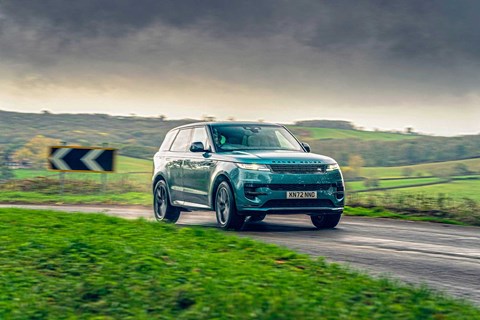
But the Sport’s tremulous progress, particularly at lower speeds on broken tarmac, is annoying, particularly given how much time it’ll likely spend Ranging and Roving rather than actually Sporting. The Porsche Cayenne, here to remind us just how much Sporting an SUV can do, ludicrous though the notion might be, is no better, but the iX’s ability to filter out fissures, ridges and small mountain ranges is standout gorgeous in this company. Perhaps the Range Sport’s rubber is a contributing factor – all-season Pirelli Scorpions on 22-inch wheels (23s are an option on the Sport; aesthetes will consider them essential equipment). The Cayenne, by contrast, is on Pirelli P Zero Corsas, and the BMW Bridgestone Alenzas.
The Range Rover’s steering set-up is unremarkably competent; light, accurate and in tune with the car’s character. The Sport’s more of the same, though with an aggressive self-centring that jars a little on first acquaintance. Neither as rapid as the iX’s rack nor as tactile as the Cayenne’s, there is at least a good deal of accuracy and sensitivity to it, and that – conjuring a semblance of a connection between you and the front axle of a 2.5-tonne (2430kg) SUV – is no mean feat.
You get used to the off-centre tug, and the faster you’re going the less it matters, but the unspectacular ride quality and the woolly grip do see you instantly questioning the Sport remit. And, in my case, at least, longing for a D350 Range Rover instead…
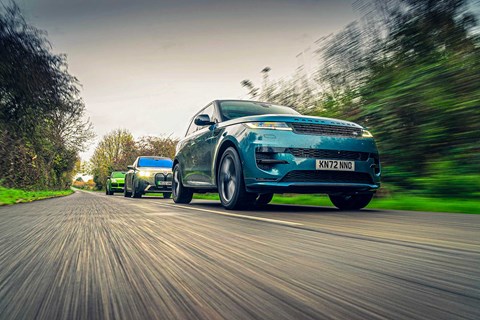
To an extent those concerns fade as you begin to use the Sport as intended. I first experienced its poise and balance from the passenger seat, with development boss Matt Becker driving, on a dry Goodwood circuit. The car monstered the dauntingly quick track but Becker’s skills at the wheel and his attribute-tweaking mixing desk could only mask the issues intrinsic to SUVs, namely their shape and weight, to an extent. While he took liberties most everywhere, he didn’t try to blend slowing down and turning.
It’s the same on the road. You learn not to get carried away, and to avoid overlapping braking and changing direction. Instead, lean on the brakes (good and powerful) in plenty of time, come off them and commit. Back in the summer, at Goodwood, the front axle was unerringly reliable. But that’s not the case today. The all-season rubber and greasy conditions give rise to confidence-sapping understeer.
Get through the fuzziness and the Sport clings on well, with strong body control, adept torque vectoring and an all-wheel-drive system so nicely tuned it’s happy to get on and ladle tonnes of torque into the mix just as soon as you’re sure you’re pointed in the right direction. A more pronounced rear bias would be nice, though, to up the Sport’s sportiness and distance it from the Range Rover. That said, the balance as it is (together with the fact that DSC Off appears still to leave plenty of ESC on) is probably a good thing all told – I refer you to this story’s intro…
The powertrain’s a little dozy in anything but Dynamic mode but crank things up, get manual on the paddles and you soon find yourself tuning into the Sport’s natural rhythm. It isn’t a lairy machine, with a character a world apart from, say, Jaguar’s F-Pace SVR or the Porsche we have here. And rightly so – it is badged Range Rover, after all.
Instead it’s (mostly) composed and quick rather than ragged and rapid, and beautifully balanced and communicative. Its limits might be weirdly low on this rubber, in these conditions, but you know exactly where you are with it, and increasingly confident weight transfer, steering inputs and throttle applications are rewarded with reduced understeer and faster progress. The engine plays no small part here, coming in all velvety and butter-wouldn’t-melt at low rpm but pulling hard from 2500rpm, convincingly from 4000rpm and spectacularly from 5000rpm.
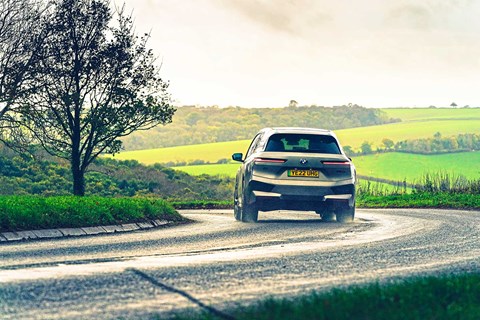
Want to make a potent V8 feel as gutless and impotent as a two-stroke scooter? Jump into BMW’s iX M60. Do so cold, with no prior iX flying time under your belt, and Munich’s electric SUV is an assault on the senses – in the nicest possible way. Much of the iX, inside and out, feels £120,000 appropriate – never a given with BMW. The frameless door clangs shut in a jarringly cheap way (frustrating given they close into an aperture buttressed with fabulously expensive-looking carbon weave) and you find yourself clutching the bizarrely hexagonal steering wheel in a space that feels less car and more flagship hi-fi store.
A lifetime of BMW ownership is no preparation, either for the iX’s philosophy and feel or for the way it drives. Instead, this feels like a deliberate shedding of the past – like the ‘Don’t scare ’em off!’ manifesto that informed the incredibly conservative i4 and iX3 was casually tossed in the shredder, the team that masterminded the before-its-time i3 freed from its basement oubliette and the kind of unchecked ambition that Munich traditionally poured into its flagship 7-series direct-injected into the iX at unprecedented levels of concentration and intensity.
Get moving and, if the Range Rover Sport feels no more compact than a full-size Range Rover, the iX feels little bigger than an i3. Its external proportions are undoubtedly odd but the payoff comes in the form of fantastic sight lines and a genuinely very special sense of light and space from the vast glasshouse and low bonnet. Progress is effortless in the truest sense of the word, the instantaneous drive and puppydog-enthusiastic steering rack conspiring to see the iX flitting about the place like a car half its size (and weight).

Of the drive modes Expressive strikes the most compelling balance: responsive without being hair-trigger; controlled yet pliant. Wind the regenerative braking effort right back and the car you unearth is remarkably organic and predictable in its responses – oddly so, given how complex it is.
Performance is staggering. Overtakes are done as soon as they begin, steep slopes are flattened and, so accelerative is the BMW, it’s even a card-carrying member of the elite club able to harmlessly leapfrog slower traffic as they huff and puff back up to speed after a junction or roundabout – 0-62mph in 3.8sec will do that for you. And remarkably, the iX’s chassis copes. Its agility has to be experienced to be believed, as does its mid-corner grip and balance, and the damping is such that it doesn’t even register the awkward lumps that leave the Range Sport needing a moment or two to recover.
As James points out, the driving experience isn’t rewarding in the same way as the Cayenne’s, feeling an order of magnitude or two more less intimate. But there’s no denying the BMW’s ability, nor its awesome cruising refinement when you find yourself on longer, more mundane journeys.
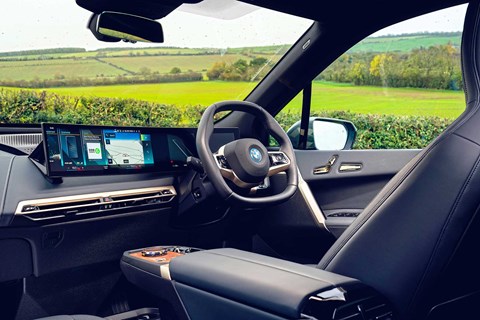
And so the iX begins to tunnel its way into your heart, scaling your barriers with its brilliant interface, gorgeous interior, generous space, dazzlingly screens, impeccable self-parking and convincing drive assist, which’ll now go close to 20 seconds on a motorway without getting agitated. Truly this feels like a car you’d grow to adore, its proficiency at everything from covering ground like an M5 to taking your breath away with its majestic sound system delighting you on a daily basis.
The Cayenne is slower, more conventional and considerably prettier than the BMW, particularly in green on five-spoke rims so big they make this coupe-roofed SUV look like a hot hatch. The Porsche also offers a far richer and more rewarding driving experience than either rival can manage. Yes, there’s loads of road texture and rumble from the tyres, suspension and structure – the iX is like a sensory deprivation chamber in contrast. But in the Porsche you don’t want it any other way. You want to feel everything; every grain of tarmac, every shred of grip, every shift and smear of the hard-working Pirellis. And you do.
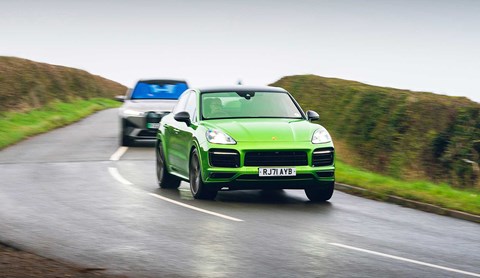
The shifts are more immediate and satisfying than the Sport’s, the V8 more urgent and keener to have you explore its high-rpm surge whenever you’ve the required clear roads (and fleeting financial liquidity).
Again, the difference in rubber surely tells here, in conditions that are wet but not cold. On its Pirellis the Porsche monsters the Land Rover as a driving tool. There’s so much more grip, such clean and flat cornering and no lost body movement, no waiting for anything to recover or catch up.
Balanced, responsive, cohesive, rear-biased, exploitable and, yes, hugely enjoyable, this is the best car to drive in this group and, it must be said, likely in many others.
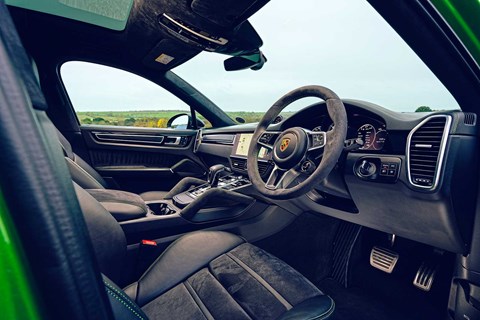
For James, that should make it the best car here. But he’s in possession of sufficient perspective to appreciate that the fact the Cayenne rides like a sports saloon (firmly, if with a sophisticated edge to the damping) may, for many, defeat the fundamental point of an SUV – to cosset, and to be comfortable.
Certainly the £1400 adaptive sports seats, while reassuring in their embrace after the iX’s desert-flat and oddly unsupportive equivalents, aren’t all-day comfortable, and town work is miles from the Cayenne’s preferred theatre of operations (distance work at speed or the kind of roads you’d seek out in a 911).
Three cars, myriad startling contrasts. Decision time.
Verdict: Range Rover Sport vs BMW iX vs Porsche Cayenne
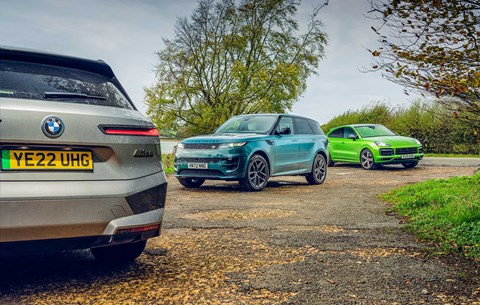
In our three-car Range Rover test six months ago, the Cayenne Turbo S E-Hybrid, huge fun in small bursts, placed third. The Porsche goes two better this time round to claim the win. Allow me to explain…
There’s much to admire about the new Range Rover Sport. Handsome inside and out, by turns soothing and scintillating depending on your settings, and in possession of genuine off-road ability that leaves its rivals floundering, it’ll enrapture the faithful.
But it’s hamstrung here by the dynamic banana skin of all-season rubber, and can’t win a test based on what it might feel like on more appropriate tyres. It ditches some of the Range Rover’s outstanding ride quality but then, in the case of this car at least, fails to convince as the driving tool it strives to be. Less composed and capable than either the Porsche or the BMW, and with little of the latter’s innovation, it crosses the line third.

With an uncomplicated blown V8 under the bonnet, the Cayenne makes a whole heap of sense in GTS guise. Desirable, beautifully made and rewarding to pilot to a degree that comprehensively out-strips the other two, the Porsche is a wondrously well-resolved driving machine. Just be sure to go in with your eyes open. You don’t get something for nothing, and the payoff for the grip, body control, tactility and cornering poise to keep a 911 honest is plenty of tyre roar, a tough ride that hates low-speed urban work and a paucity of the Zen-like waftiness that defines the iX.
The BMW iX M60 is a special car, and so nearly our winner. Its foundations are rock solid, not least a chassis that rides better than either rival and yet still humbles even the most daunting roads at scarcely credible speeds But it’s what the iX layers onto this hugely competent core that makes you yearn to spend more time with it. The vast, light-filled atrium of an interior; the stunning displays (backed up by a powerful yet entirely user-friendly interface); the hushed serenity on the move that has to be experienced to be believed; the zero-lag and incendiary powertrain.
The iX M60 oozes ambition. Where the Cayenne and Range Rover Sport feel like traditional SUVs, albeit beautifully evolved and resolved, the bespoke, clean-sheet iX is the fast SUV thoroughly and thrillingly re-imagined.
More comparison tests by CAR magazine